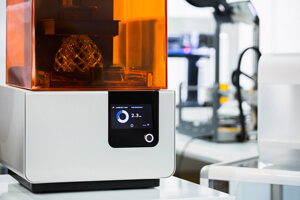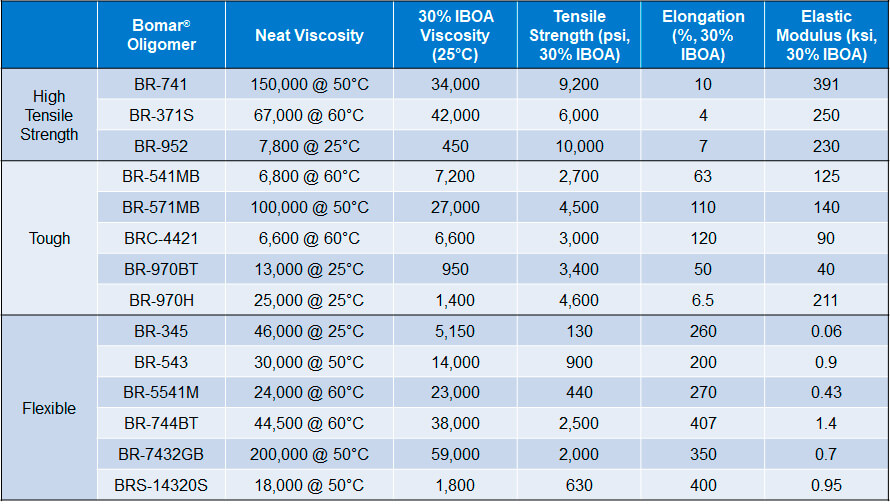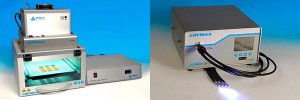
 The expansion of 3D printing into rapid manufacturing applications and strong market demand for next-generation oligomers, has been coupled with an increased demand for materials with a wide variety of physical properties. Rigid materials, with high tensile strength and low elongation, are readily available, but offerings of tough, flexible materials with high elongation are more limited.
The expansion of 3D printing into rapid manufacturing applications and strong market demand for next-generation oligomers, has been coupled with an increased demand for materials with a wide variety of physical properties. Rigid materials, with high tensile strength and low elongation, are readily available, but offerings of tough, flexible materials with high elongation are more limited.
As more and more manufacturers look to replace traditional mass manufacturing processes with 3D printing, they are striving to create new, higher quality printing materials that overcome problems with deformation, have superior surface quality, and provide better mechanical properties.
From a commercial perspective, 3D printing is very appealing, especially in applications where only relatively small number of parts are required. Additionally, strong market demand for next-generation oligomers for formulating inks and resins used in SLA, DLP, and 3D inkjet printers has been coupled with an increased need for materials with a wide variety of physical properties. However, there are several challenges preventing the realization of this potential; speed of manufacturing and meeting material performance properties being the most important.
Background

Widely used as the backbone of UV-curable 3D-printing formulations for SLA, DLP, and 3D inkjet printers, oligomers are combined with monomers, additives, and UV-reactive photoinitiators to produce UV-curable 3D-printing inks and resins. The formulation of these products requires a focus on bulk properties of the cured material such as tensile strength and elongation. Rigid printing materials are readily available, but offerings of tough, flexible products with high elongation and good impact resistance and rebound capability are more limited. A selection of Bomar® oligomers from Dymax Oligomers & Coatings were designed with these 3D printing needs in mind, including toughness, low shrinkage, thermal stability, and low color.
This selection consists of next-generation oligomers with varying Tgs that allow for flexibility in mechanical properties. Formulators looking to eliminate object deformation can select an oligomer with a high Tg and low linear shrinkage. The oligomers also cover a large range of viscosities, so formulators can achieve the flow characteristics they desire. In addition to the mechanical properties these products provide, they also are non-yellowing for higher clarity and offer color stability for better looking objects. Formulations that utilize Bomar oligomers also gain high impact resistance, making them more durable against dropping and every day wear. Additionally, oligomers for thin film applications like coatings or inks may not necessarily have the same balance of properties that Bomar oligomers can provide.
Features & Benefits of Bomar® Oligomers
- Excellent mechanical properties for products that can be used in applications beyond prototyping
- Superior surface quality and deformation resistance for better aesthetics
- High impact resistance for more durable products
- Variety of viscosities for desired flow characteristics

Light-Curing Equipment for 3D Printing Post Cure and Rework
 After a 3D model is built, it may be necessary to supply additional curing energy to the part to ensure that optimized material properties are achieved. Dymax offers UV light-curing flood lamp systems for post-curing and spot lamp systems for rework and repair of 3D-printed models.
After a 3D model is built, it may be necessary to supply additional curing energy to the part to ensure that optimized material properties are achieved. Dymax offers UV light-curing flood lamp systems for post-curing and spot lamp systems for rework and repair of 3D-printed models.
If you want to learn more about next-generation 3D printing oligomers, download our white paper “New Developments in Acrylate Oligomers for 3D Printing.”
Subscribe to Our Email Newsletter
Stay up-to-date on all the latest news from the 3D printing industry and receive information and offers from third party vendors.
Print Services
Upload your 3D Models and get them printed quickly and efficiently.
You May Also Like
Consolidation in AM: How 2025 Is Shaping the Industry’s New Normal
The first half of 2025 has been marked by a clear shift in the additive manufacturing (AM) industry. Companies are no longer just focused on developing new tech by themselves....
Etsy Design Rule Change Reduces Selection of 3D Printed Goods
Online marketplace Etsy has implemented a rule change requiring all 3D printed goods on the site to be original designs. The update to the site’s Creativity Standards states, ¨Items produced using...
U.S. Congress Calls Out 3D Printing in Proposal for Commercial Reserve Manufacturing Network
Last week, the U.S. House of Representatives’ Appropriations Committee moved the FY 2026 defense bill forward to the House floor. Included in the legislation is a $131 million proposal for...
Transforming From Tourist to Native: Duro CEO Michael Corr Explains Why the Company Rebuilt its PLM Software on AI
In these early innings of the AI boom, many market analysts have expressed concern that AI spend has gotten too far ahead of the technology’s proven ability to deliver significant...
































